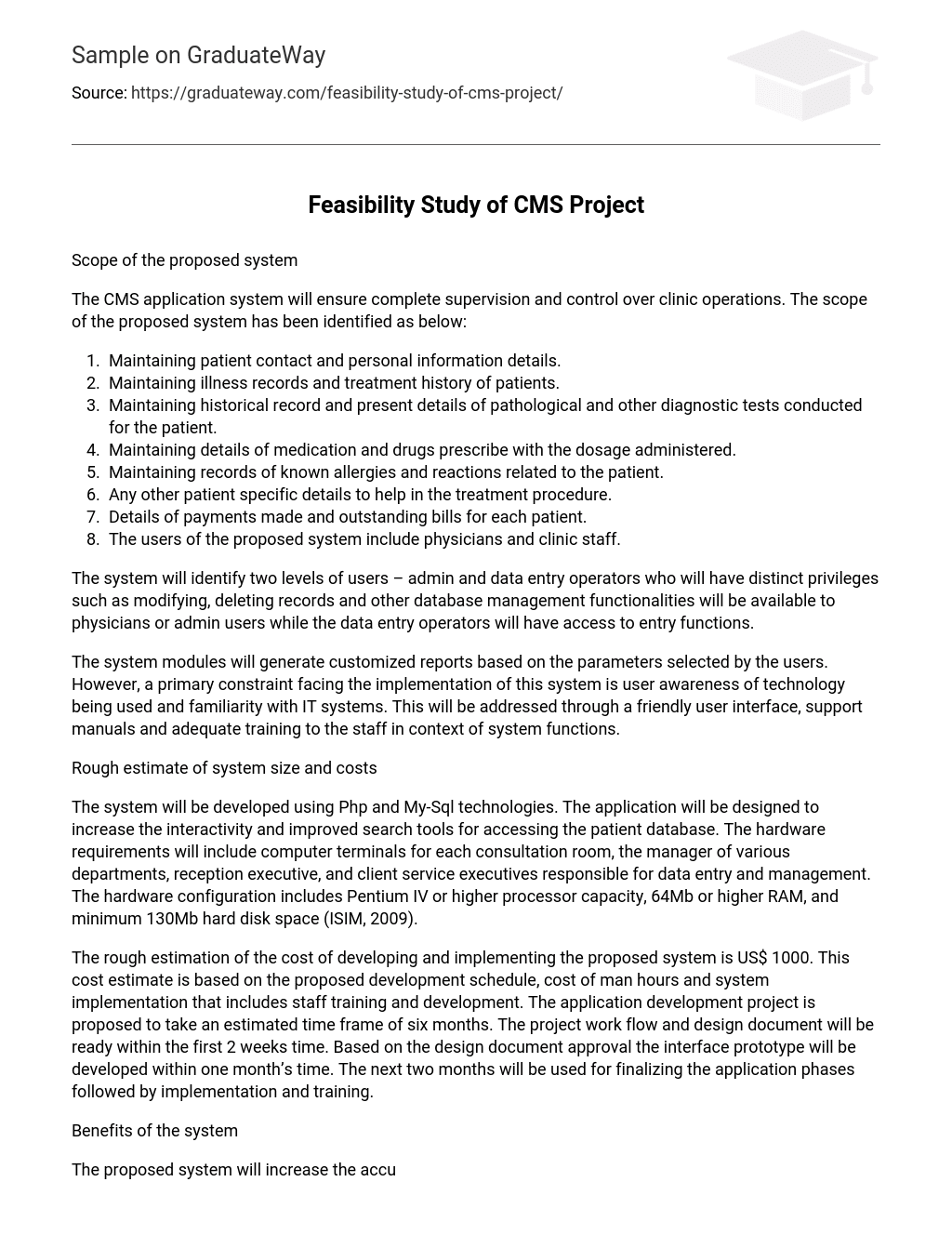Scope of the proposed system
The CMS application system will ensure complete supervision and control over clinic operations. The scope of the proposed system has been identified as below:
- Maintaining patient contact and personal information details.
- Maintaining illness records and treatment history of patients.
- Maintaining historical record and present details of pathological and other diagnostic tests conducted for the patient.
- Maintaining details of medication and drugs prescribe with the dosage administered.
- Maintaining records of known allergies and reactions related to the patient.
- Any other patient specific details to help in the treatment procedure.
- Details of payments made and outstanding bills for each patient.
- The users of the proposed system include physicians and clinic staff.
The system will identify two levels of users – admin and data entry operators who will have distinct privileges such as modifying, deleting records and other database management functionalities will be available to physicians or admin users while the data entry operators will have access to entry functions.
The system modules will generate customized reports based on the parameters selected by the users. However, a primary constraint facing the implementation of this system is user awareness of technology being used and familiarity with IT systems. This will be addressed through a friendly user interface, support manuals and adequate training to the staff in context of system functions.
Rough estimate of system size and costs
The system will be developed using Php and My-Sql technologies. The application will be designed to increase the interactivity and improved search tools for accessing the patient database. The hardware requirements will include computer terminals for each consultation room, the manager of various departments, reception executive, and client service executives responsible for data entry and management. The hardware configuration includes Pentium IV or higher processor capacity, 64Mb or higher RAM, and minimum 130Mb hard disk space (ISIM, 2009).
The rough estimation of the cost of developing and implementing the proposed system is US$ 1000. This cost estimate is based on the proposed development schedule, cost of man hours and system implementation that includes staff training and development. The application development project is proposed to take an estimated time frame of six months. The project work flow and design document will be ready within the first 2 weeks time. Based on the design document approval the interface prototype will be developed within one month’s time. The next two months will be used for finalizing the application phases followed by implementation and training.
Benefits of the system
The proposed system will increase the accuracy of data and information transferred from one clinical department to another. It will also ensure a planned approach to managing data and patient information within the clinic. The physicians will be able to access information within seconds thus saving time and costs of maintaining manual records. The integration between various departments within the clinic will benefit some key operations such as – senior management in accessing vital information for decision making, pathology department in transferring patient diagnostic data, finance department in securing information related to payments and salaries. This will lead to enhanced patient care facilities and efficient clinic operations and management (SingTel, 2008).
Comprehensive system feasibility analysis
The system is technically and economically viable and is a cost effective solution in terms of its role in increasing efficiency and improving operational performance. The efficiency in operations management will lead to improved image of the facilities and infrastructure resulting in increased confidence in patients (Houston Medical, 2009). Patient records and details are of vital importance in future treatment options and historical record maintenance. An automize data driven management solution will help in improving the way hospitals and clinics provide patient care services. Hence it is a viable business solution ideal for long term business growth and development strategies.
Experience of the hypothetical project design
The hypothetical project design and analysis has provided me with a practical insight into the various aspects of CMS design. It has also provided me with the analyzing capacity to infer various solutions to meet the operational requirements of the CMS. The whole project design phase was extremely helpful in building a rational thought pattern on how the IT systems can be used effectively to promote business goals and objectives.
The design of the CMS project required a complete understanding of the clinical operations, data flow requirements and an analysis of solutions that can be provided to increase the efficiency of data management. The project was hence effective in developing analytical skills and organizing thought process to deliver effective solutions.





